Ali– Now that we are no longer living in Switzerland, it’s hard to sustain a blog about life in Switzerland. But I can’t quite bring myself to give up Swissfamilyabraham.com. So I might as well use the site as a general travel blog, documenting all the places Maya has been ‘forced’ to visit and publicly displaying all the photos she has sullenly sat for. It will serve as a priceless trove of embarrassing material for years to come.
This year for the winter holiday I decided we would visit the Andalusia region of southern Spain. I was there briefly back in March for a conference and never made it to the famous Alhambra because one needs to buy tickets 3 months ahead of time. Since Spain and Morrocco are separated by as little as a 1 hour ferry ride, I thought we should also take the opportunity to experience a taste of Northern Africa.
We arrived into Menara airport in Marrakesh on a British Air flight (still my favorite airline for the free gin and tonics) Saturday the 22nd of December after a redeye flight from JFK. The Riad we had booked for our stay arranged to have a car waiting for us, which gave us our first harrowing introduction to the chaos that is getting around in the Médina. At one point our driver said to us, “Please don’t drive in Marrakesh.” It’s hard to give you a sense of the experience but try to picture narrow alley ways bounded by tall crumbling walls lined with small shops and vendor carts between which cars, mopeds, bicycles, pedestrians and donkeys all fight to pass.
Our host from Riad Dar lalla f’dila met us and walked us into the labyrinth of the Médina to the Riad. 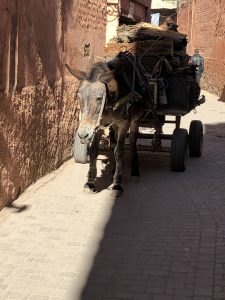
No path was straight and they all had the same ancient ruin like appearance with only a sliver of the sky available for navigation by stars. At one point he stopped and tried to orient us. “That way is Ben Youssef Madrasa and there the Marrakesh Museum, turn at the Hammam.” I just nodded and smiled. We were never getting out alive. It was like finding oneself in the Hunger Games and deciding just to try to enjoy the experience until some agile youngster with a bow took you out.
In contrast to the loud crush of humanity outside, the Riad was an oasis of tranquility.  Riads are communal living with bedrooms off a central open courtyard. The one we were staying in had once housed Josephine Baker and she was a prominent part of the tour of the building. “Here is bedroom where Josephine Baker slept. …Here is sitting room where Josephine Baker had tea. …Here is Hammam where Josephine Baker was naked and scrubbed with salt.”
Riads are communal living with bedrooms off a central open courtyard. The one we were staying in had once housed Josephine Baker and she was a prominent part of the tour of the building. “Here is bedroom where Josephine Baker slept. …Here is sitting room where Josephine Baker had tea. …Here is Hammam where Josephine Baker was naked and scrubbed with salt.”
After settling in we decided to wander the Médina and the famous Souks. The Souks are giant labyrinthine market places where every manner of good can be acquired after some serious haggling. 


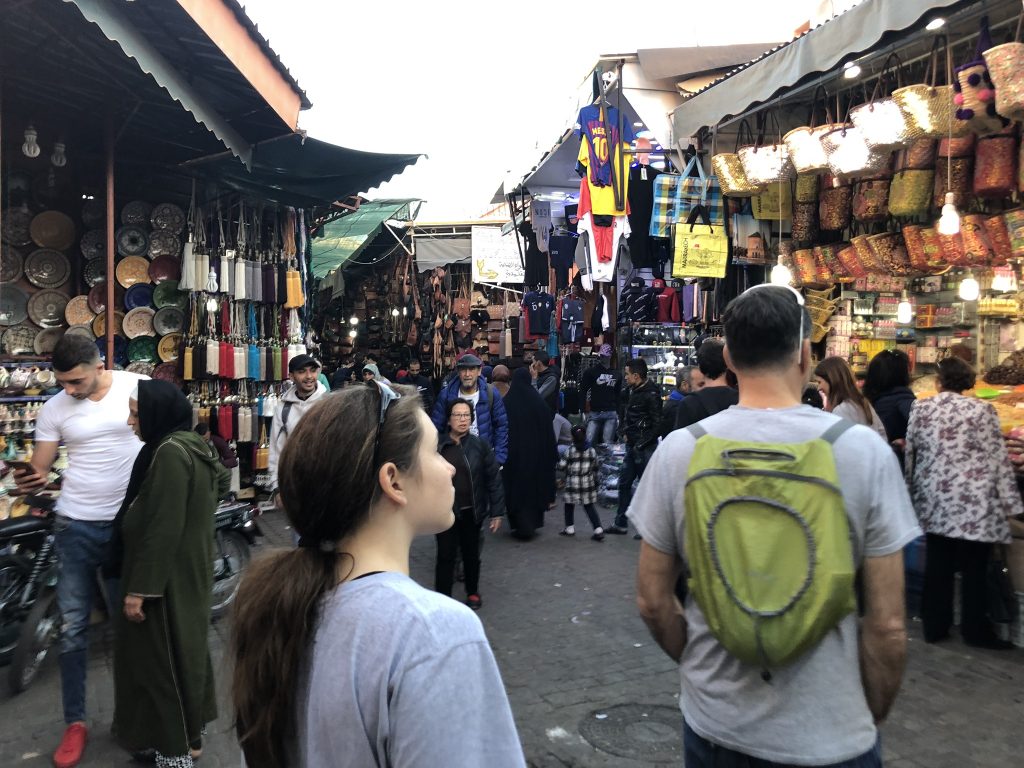
I think the charm of the place lasted about 15 minutes. The dominant languages are French and Arabic and each victim (a.k.a tourist) is aggressively hassled to purchase goods, first in these languages and then in any language you might speak. I tired to fend them off by speaking German: “Ich verstehe nicht! Ich spreche nur Deutsch!”, where upon I found myself being hit on by a ragged looking local who apparently had a thing for German women. “Errrrr… mein Mann ist dort drüben. Der Größer…”
Maya disliked the whole place after about 5 minutes. The aggressive selling combined with the fear of being trampled by a donkey at any moment was too much for her. In fact I would say one would have to be either a sadomasochistic shopper or a belligerently committed adventure seeker to enjoy the Médina for very long. Any charm was quickly drowned by the stench of exhaust fumes from the steady flow of mopeds nipping at your heels. But once you fought through the maze like Arnold Schwarzenegger in Running Man, there were a couple cool things to see. The Saadian tombs from the 16th and 17th century Saadian dynasty are beautiful and have cool old dead guys. The El Badi Palace is a massive old palace. I read that when it was built the sultan Almad al-Mansur turned to the court jester and asked him what he thought of the sultan’s new palace. The jester said, “Your highness it will make a fabulous ruin!”
The El Badi Palace is a massive old palace. I read that when it was built the sultan Almad al-Mansur turned to the court jester and asked him what he thought of the sultan’s new palace. The jester said, “Your highness it will make a fabulous ruin!”
 Ah the wisdom of comedians. The Jemaa el-Fnaa square is the Médina on steroids. A giant central square where you feel like the lone red blooded mammal in a room full of mosquitos. The juice sellers and the henna painters were by far the most persistent going so far as to grab Maya’s hand and glop henna on her before Joe could retrieve her. However the snake charmers are worth the risk of accidental henna-ing and juice consumption.
Ah the wisdom of comedians. The Jemaa el-Fnaa square is the Médina on steroids. A giant central square where you feel like the lone red blooded mammal in a room full of mosquitos. The juice sellers and the henna painters were by far the most persistent going so far as to grab Maya’s hand and glop henna on her before Joe could retrieve her. However the snake charmers are worth the risk of accidental henna-ing and juice consumption.
 One of the best sites wasn’t on the normal tourist list. La Mamounia Hotel is a bit outside the old city and is apparently the best hotel in Africa by some metric. The gardens are indeed worth a visit and non guests are free to wander about and drink Morroccan mint tea (which is deliciously diabetes inducing) with fancy French macaroons.
One of the best sites wasn’t on the normal tourist list. La Mamounia Hotel is a bit outside the old city and is apparently the best hotel in Africa by some metric. The gardens are indeed worth a visit and non guests are free to wander about and drink Morroccan mint tea (which is deliciously diabetes inducing) with fancy French macaroons.

 The hotel gardens even beat out the Jardin Majorelle designed by an artist in the 1930s and refurbished by Yves Saint-Laurent in the 1980s. Sad when a hotel out-designs an artist and a fashion designer.
The hotel gardens even beat out the Jardin Majorelle designed by an artist in the 1930s and refurbished by Yves Saint-Laurent in the 1980s. Sad when a hotel out-designs an artist and a fashion designer.
The other highlights were our hot air ballon excursion, which cost $200 per head to sit under a blast furnace and float above Morocco but worth every penny, and the Christmas Eve dinner at our Riad with the other guests (a lovely Japanese family and a French mother and daughter). The Riad hired a Moroccan band and they forced Maya to dance to her utter horror. $45 a head and again, worth every penny.

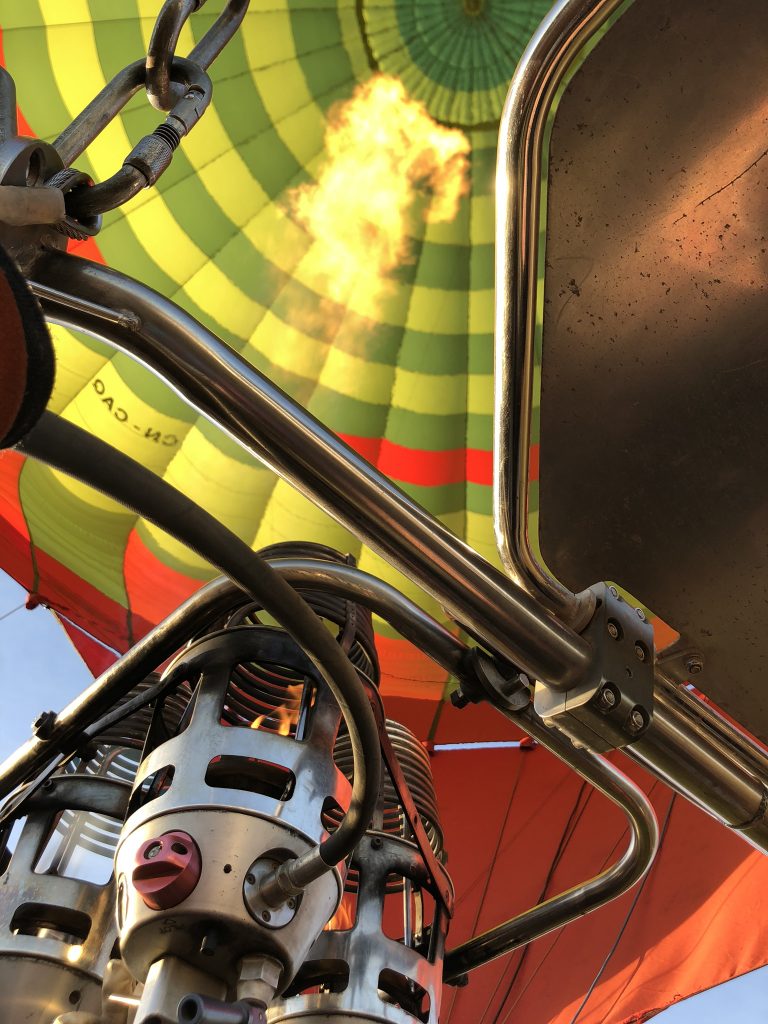
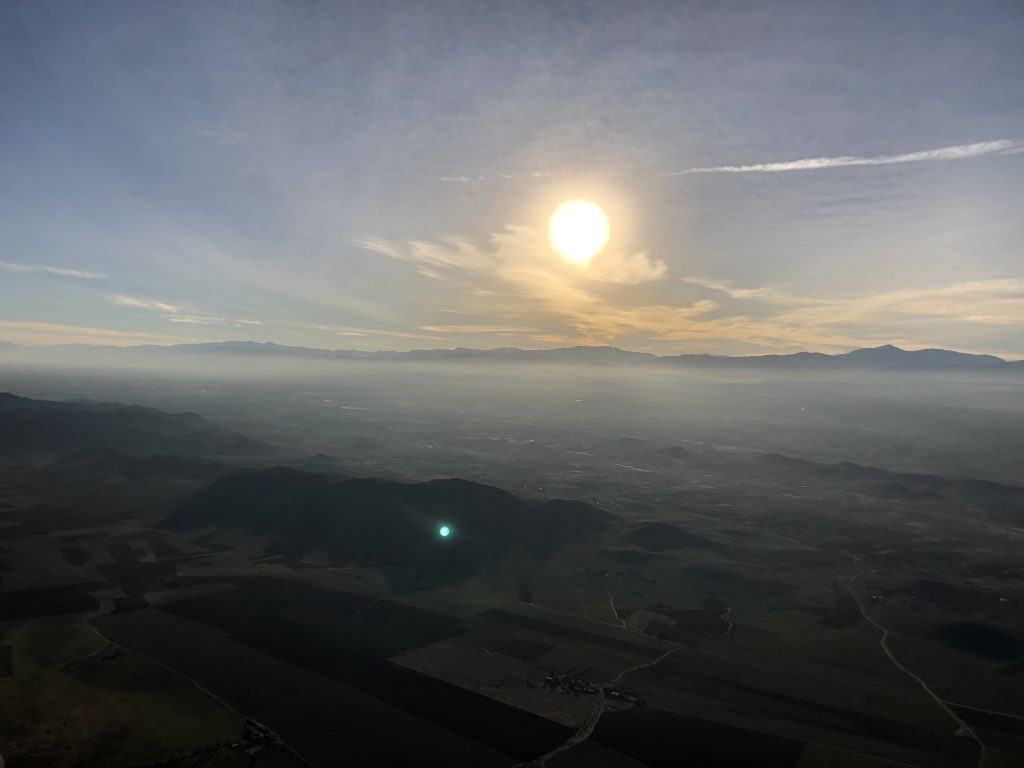
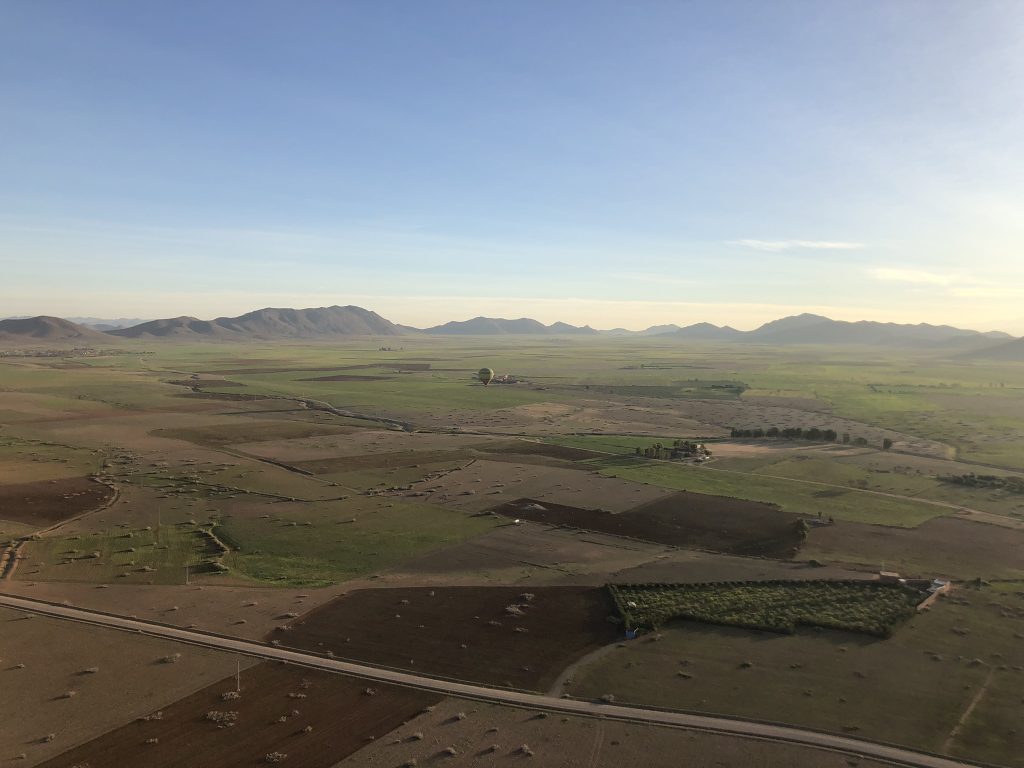

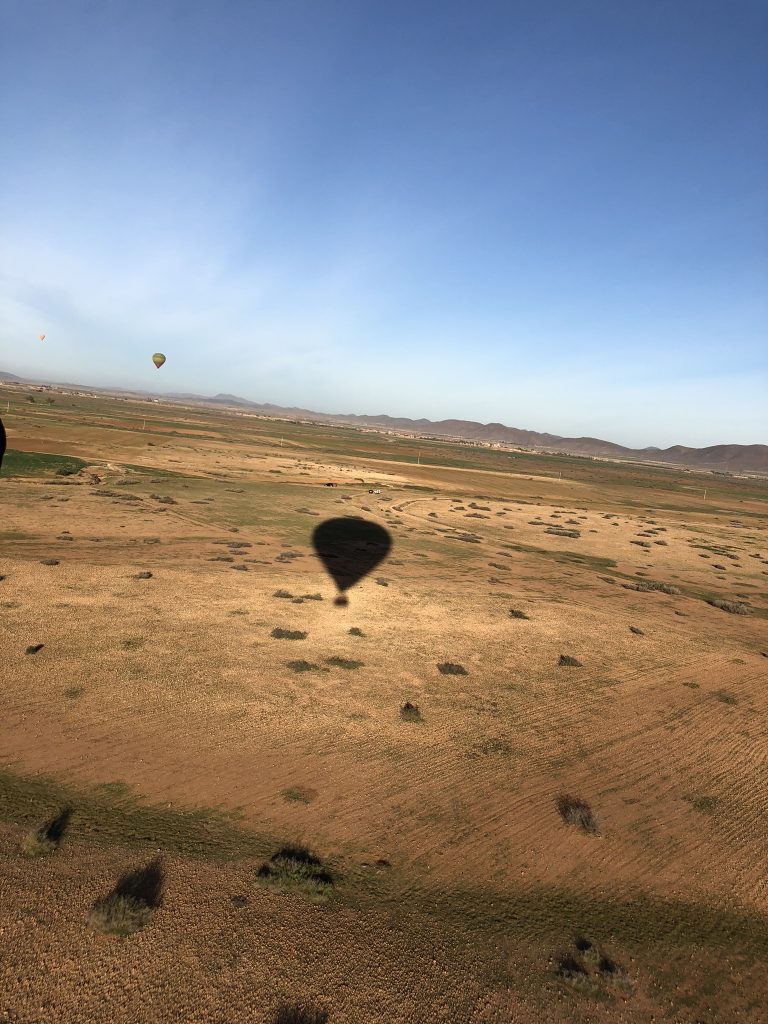
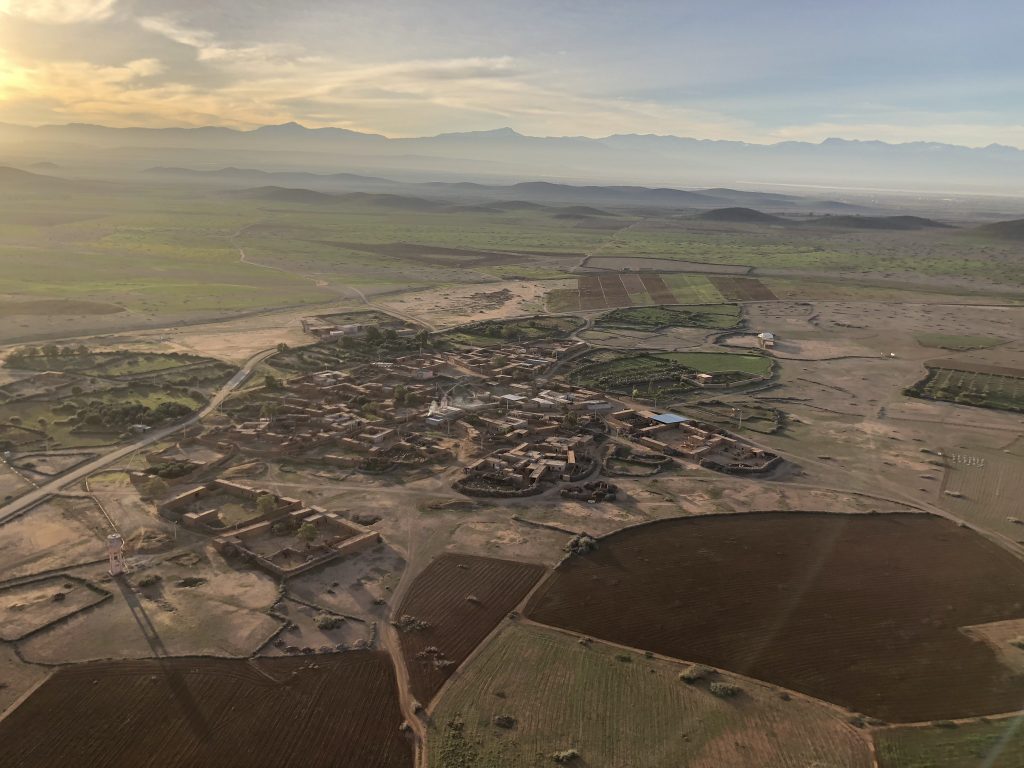
 We were not sad to board our night train to Tangier on Christmas night. The night train features couchettes that provide a combination train/hotel experience. Since we had a 575 km trek ahead of us to get to the Morrocan ferry port, traveling by night seemed the best way to maximize our traveling efficiency.
We were not sad to board our night train to Tangier on Christmas night. The night train features couchettes that provide a combination train/hotel experience. Since we had a 575 km trek ahead of us to get to the Morrocan ferry port, traveling by night seemed the best way to maximize our traveling efficiency.

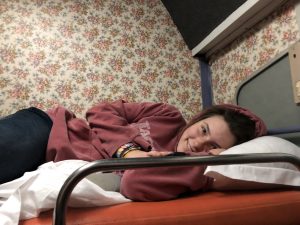
However, Moroccan train tickets can’t be purchased from outside the country so our Riad host was kind enough to buy them for us. This worked imperfectly – our Moroccan host had apparently never taken the night train. So we ended up with seats instead of beds. Luckily we were able to dash back to the ticket counter and pay an extra 170 dirams (about $17) cash to get beds and settled in for the night. At 7 am we arrived in Tangier after a 10.5 hour train trip of which Joe slept 10 to 20 minutes.

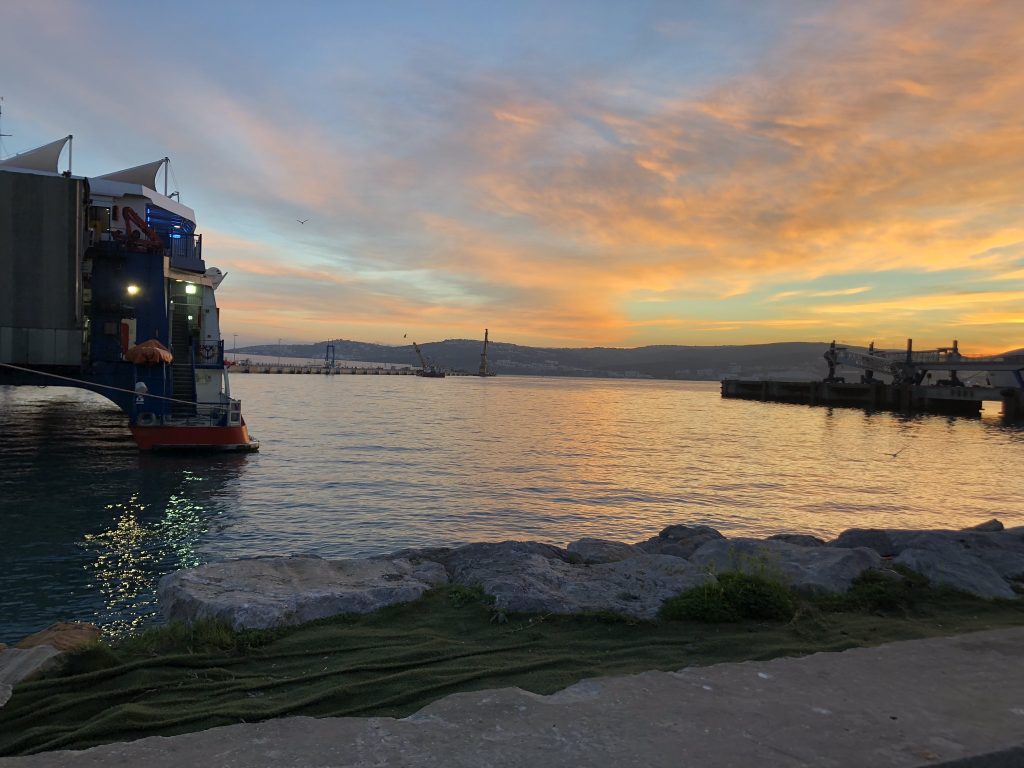


Blurry eyed we took a taxi to the ferry port and caught an intercontinental ferry to Tarifa in Spain. Now there would be nothing that spectacular about the ferry ride between Tangier and Tarifa if it wasn’t for the fact that one is traveling the waters near the straight of the Gibraltar and crossing between Africa and Europe. That is just cool.
Otherwise we were in a Spanish version of the movie Planes, Trains and Automobiles. We caught a bus in Tarifa to Algeciras, where we took a taxi to Malaga and then a train to Córdoba. This was all rather improvised as I found the train, bus and ferry websites rather unfathomable when I was researching our transportation options from the US and decided just to leave it up to the travel gods. I should mention that all this was negotiated using my two years of adult education Spanish (way to go Profesora Jeanie Murphy!). In fact my high school French got us through quite a bit of our Morrocan travels. So the lesson here is that even rudimentary language skills are actually quite helpful. I am barely functional in 4 languages (including English) and yet I will always be able to get coffee and pee throughout most of the non-Asian world. Not bad.
Arriving in Córdoba we hiked to our AirBnB in the old city. Córdoba was the greatest capital city in Europe in the 10th century. It was ruled by the Visigoths until the 700s when the Moors boated across from Africa and overthrew them. Thus began Moorish rule in southern Spain. Lots of famous scholars and philosophers came out of this period: : Averroes and Maïmōnídēs for example, a couple guys you might have heard of. For the most part, Jews, Christians and Muslims coexisted in the Moorish Caliphates of Spain. Then came the Christians who drove the Moors out in the name of the Catholic Church. Granada was the last to fall to Isabella and Ferdinand in 1492 – a very busy year for the monarchs it seems. In fact Columbus met with them in the Alcázar de los Reyes Cristianos in Córdoba – one of the very popular tourist sites – that same year to prepare for his voyage to the Americas. The Alcázar was also the headquarters of the Inquisition starting in 1482. I can see why; it has lovely gardens that provide a pleasant respite from the rigors of torture and forced Christian conversions. Needless to say Spain was far less religiously tolerant until 1834 (Unbelievable right??!?) when the Inquisition was officially disbanded.
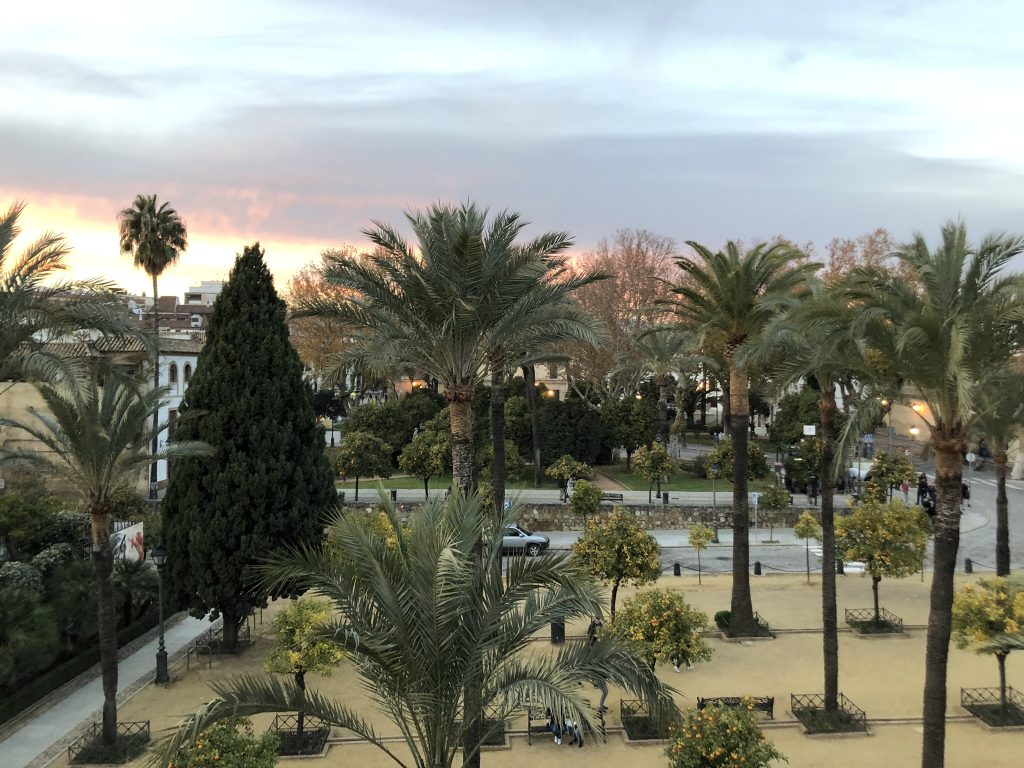



But aside from the dark history, Córdoba is delightful with beautiful architecture that combines Roman elements with Moorish and Gothic features. In addition to the Alcázar, the Mezquita is the other truly awe inspiring site. It began life as a Visagoth church and then became a mosque that reached epic proportions and then was converted into a cathedral. Joe estimated you could fit about 8 football fields inside. There is also a bell tower; I make it a point to go up every bell tower I come across to get a sense of the city layout and look for friendly hunchbacks.
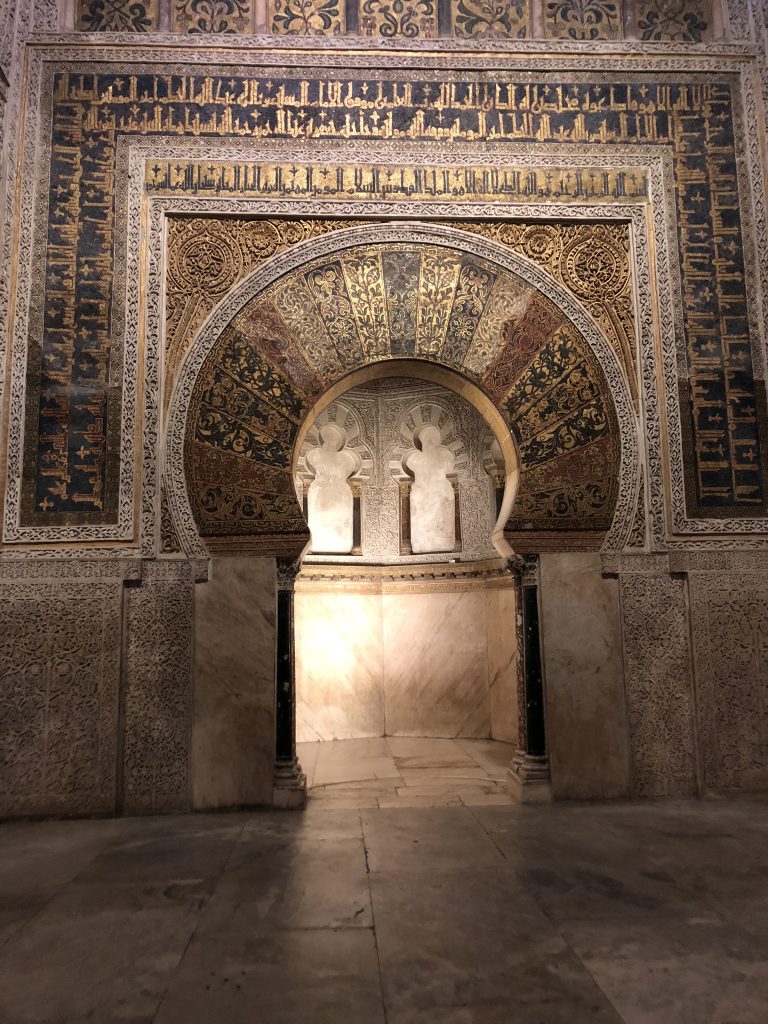

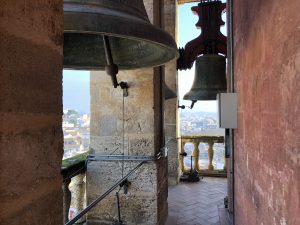
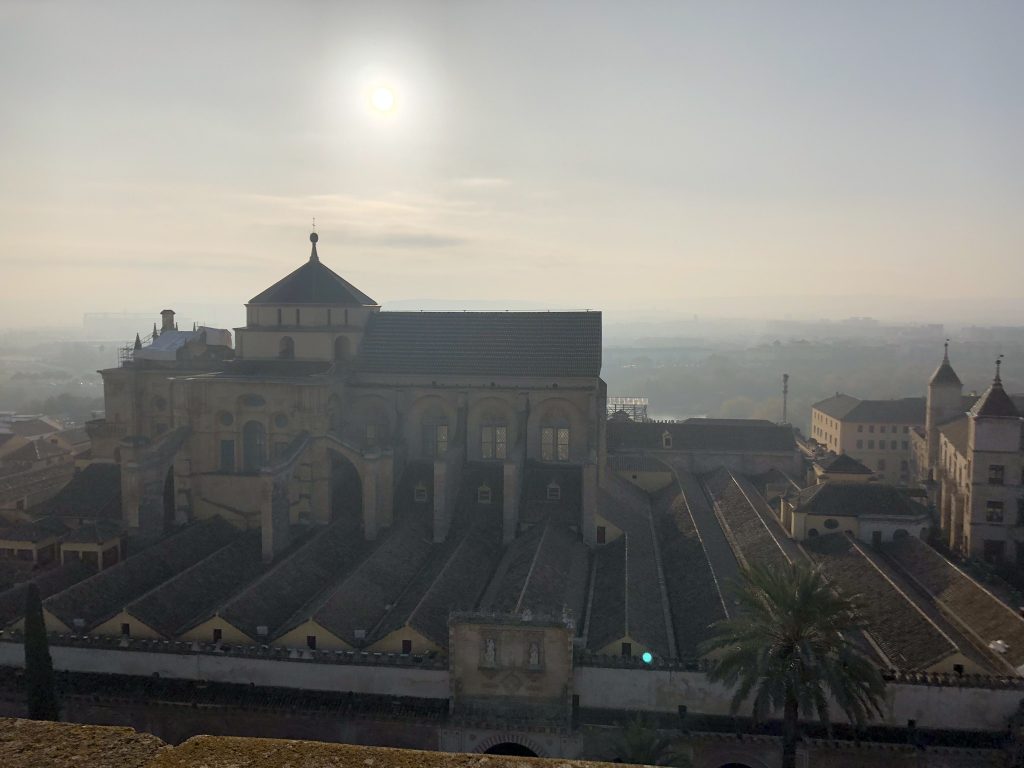
 Córdoba is also known for its flower adorned patios. We visited a lot of patios and did a couple museums and the Roman bridge, often without Maya, who played the teenage card and stayed in the AirBnB with her phone, the only one on the trip who truly understood her.
Córdoba is also known for its flower adorned patios. We visited a lot of patios and did a couple museums and the Roman bridge, often without Maya, who played the teenage card and stayed in the AirBnB with her phone, the only one on the trip who truly understood her.
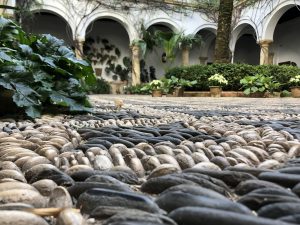 We did manage to drag her to the Adalusian horse show, which was pretty amazing (sorry, no photos allowed). Also don’t judge me when you notice Maya is wearing the same sweatshirt in every photo; you can lead a teenager to good hygiene but you can’t make them practice it.
We did manage to drag her to the Adalusian horse show, which was pretty amazing (sorry, no photos allowed). Also don’t judge me when you notice Maya is wearing the same sweatshirt in every photo; you can lead a teenager to good hygiene but you can’t make them practice it. 
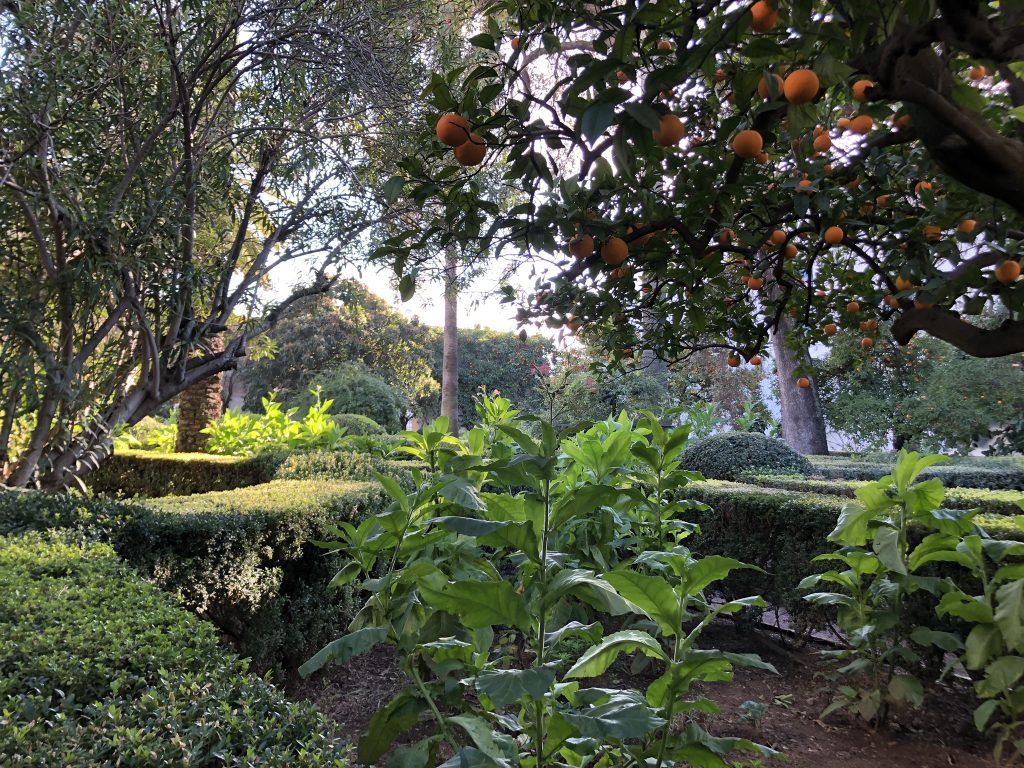

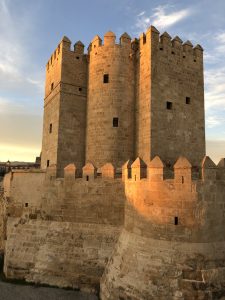

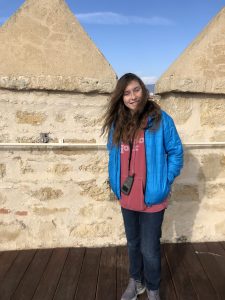
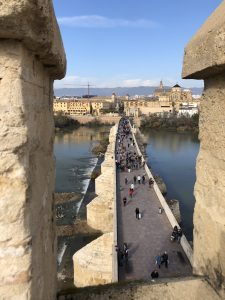 On out last night in Córdoba, Joe and I went to a restaurant with a free Flamenco show. There was a guitarist, a singer and a dancer, and one had the feeling that they were each doing their own thing but it somehow all came together – likethe Traveling Wilburys if George Harrison had been a female Flamenco dancer. The passion each performer brought to the show was really fantastic to watch. I think my picture of the singer pretty accurately captures the spirit of Flamenco and maybe Andalusian culture in general.
On out last night in Córdoba, Joe and I went to a restaurant with a free Flamenco show. There was a guitarist, a singer and a dancer, and one had the feeling that they were each doing their own thing but it somehow all came together – likethe Traveling Wilburys if George Harrison had been a female Flamenco dancer. The passion each performer brought to the show was really fantastic to watch. I think my picture of the singer pretty accurately captures the spirit of Flamenco and maybe Andalusian culture in general.
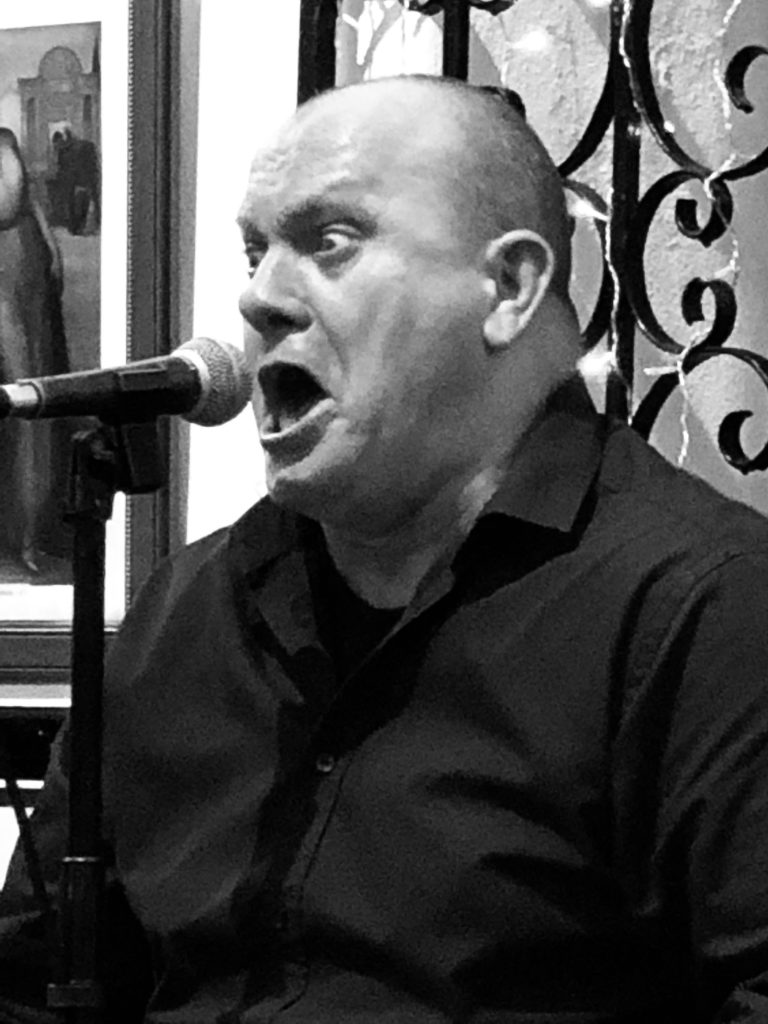
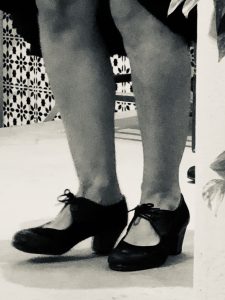



At 8:30 am on the 29th we grabbed a bus to Granada, the home of the famous Alhambra. I had purchased both day and night tickets for the 29th, taking no chance that we would miss it due to a transportation mishap given the impossibility of gaining entrance without booking far far far in advance. You may be wondering why we would take a bus when Europe has perfectly good trains. Well for some reason Granada is not so easy to get to by train – it’s about 2.5 hours by train and one must transfer in Aguilar de la Frontera. The bus is also 2.5 hours and only 45 Euros for 3 so… bus it was. For your informational purposes, the Spanish bus system is ALSA and the train system is Renfe, and both have online ticketing websites but the schedules are not available that far in advance it seems.
After a successful arrival in Granada we settled into our AirBnB which looked out on Alhambra. Our host, Nacho, was a history buff and he spent 30 minutes telling us all about the Moorish and Christian periods of the city. One thing he said in passing was a revelation though it should have been obvious. I knew Christopher Columbus was searching for a western trade route to India but I never contemplated the why of his expedition, simply chalking it up to explorer’s lust to find something new, and I thought Isabella was conned into financing him. What I didn’t know was that the Spanish Inquisition that persecuted Muslims (and Jews of course) in Andalusia with her blessing had the unhappy side effect of pissing off all the Muslims in North Africa and closing trade routes to Spanish markets, effectively stifling the Spanish economy. So Isabella was actually desperate for a new trade route. In fact had Columbus not found America and it’s riches, the trade blockade might have spelled ruin for the economy and toppled the rule of Isabella and Ferdinand. It is actually quite ironic that we celebrate Columbus Day in the US as Columbus’s arrival had nothing but negative consequences for the native inhabitants of the Americas and kept the Inquisition going strong for several 100 years. Full disclaimer I am going on the authority of Nacho, the AirBnB host here and haven’t Wikipedia’d anything to verify. But we did visit the Sephardic museum in Córdoba and got enough of a taste of the degree of religious persecution in the era of Castilian Christian rule to think it could have caused quite a stir in the Muslim world.
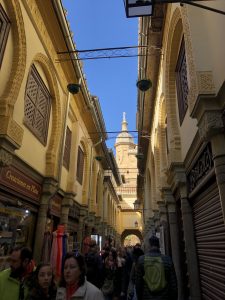
 After our history lesson we hiked up to the famous palace. We wound our way through the labrynthian streets and it became obvious to our veteran eyes that much of Marrakesh was here in Granada, the last Moorish stronghold in Andalusia and the place to which all Muslims fled as the other cities fell. The most visited tourist destination in all of Spain was visible in the distance – an imposing fortress on a hill.
After our history lesson we hiked up to the famous palace. We wound our way through the labrynthian streets and it became obvious to our veteran eyes that much of Marrakesh was here in Granada, the last Moorish stronghold in Andalusia and the place to which all Muslims fled as the other cities fell. The most visited tourist destination in all of Spain was visible in the distance – an imposing fortress on a hill.
Tickets to the Nasrid Palace specify an entrance time; ours was 3:30 pm. The detail that wasn’t so clear was that you had to first show your faces and passports at the main entrance gate way at the far side of the sprawling grounds. We thus spent the time from 2:45 to 3:30 frantically dashing between locations and getting our power walk in for the day.
The palace was indeed palatial. It was Islamic decoration in all its fine detail and glory. Intricately molded plaster and inlaid wood with beautiful Arabic script saying lots of very grand things about the sultan of the time who would remember to be a bit humble and give credit to God every third sentence or so.

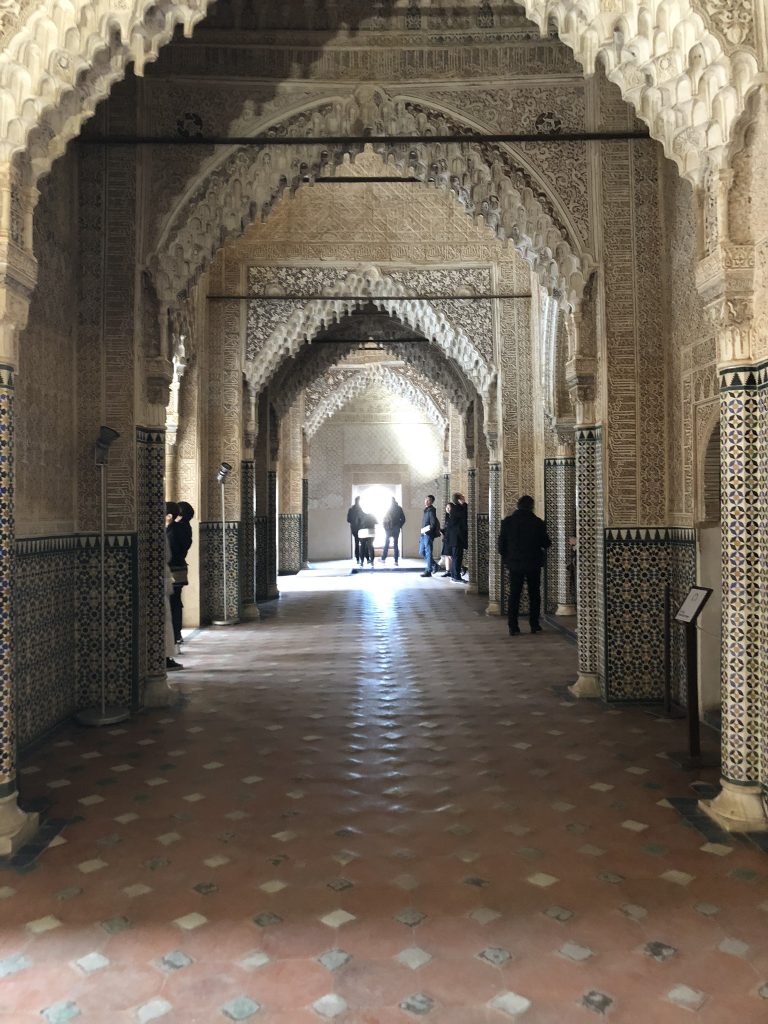

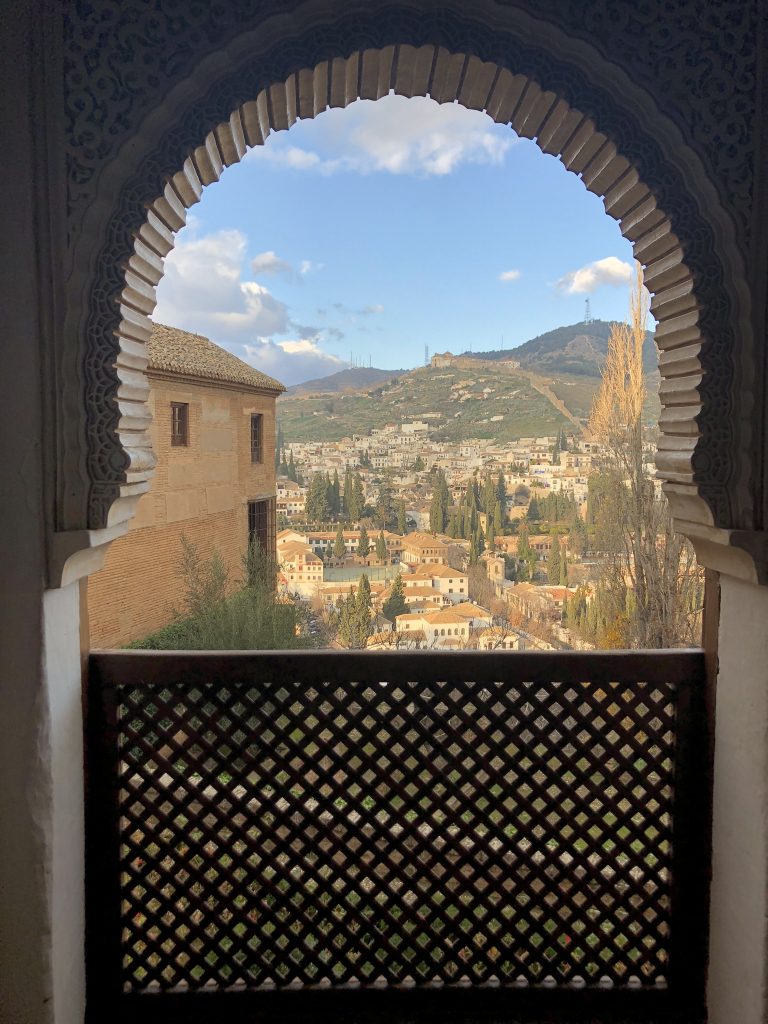

You also need tickets to go into the Alcazaba, which was the military residence and defensive structures.

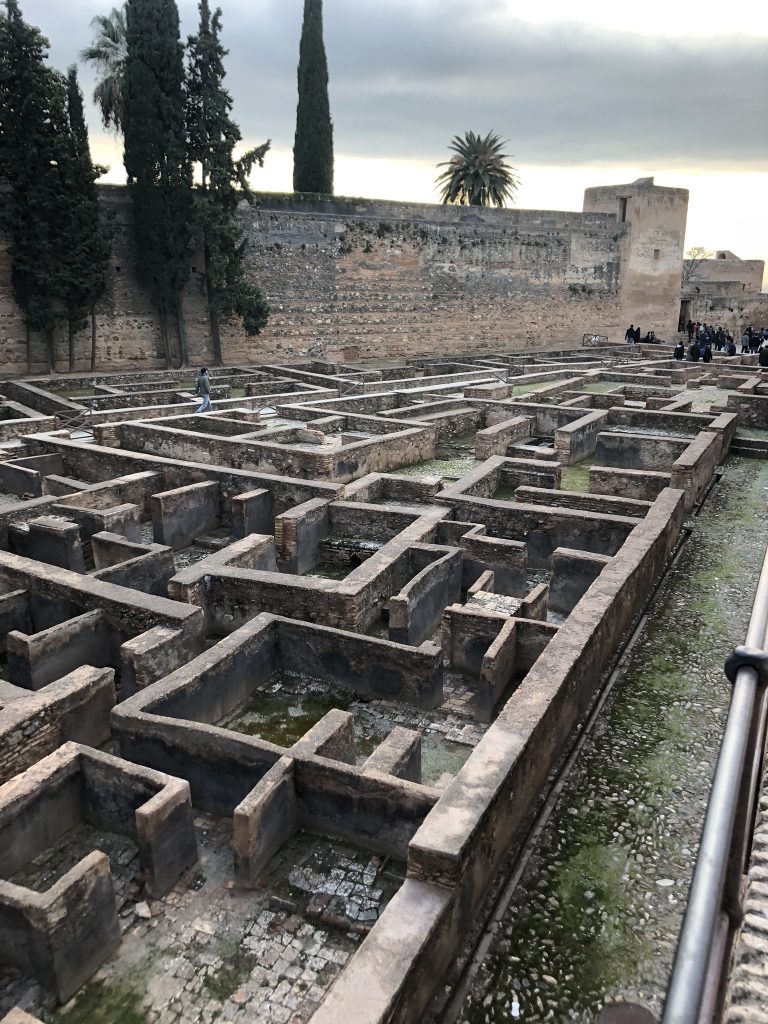

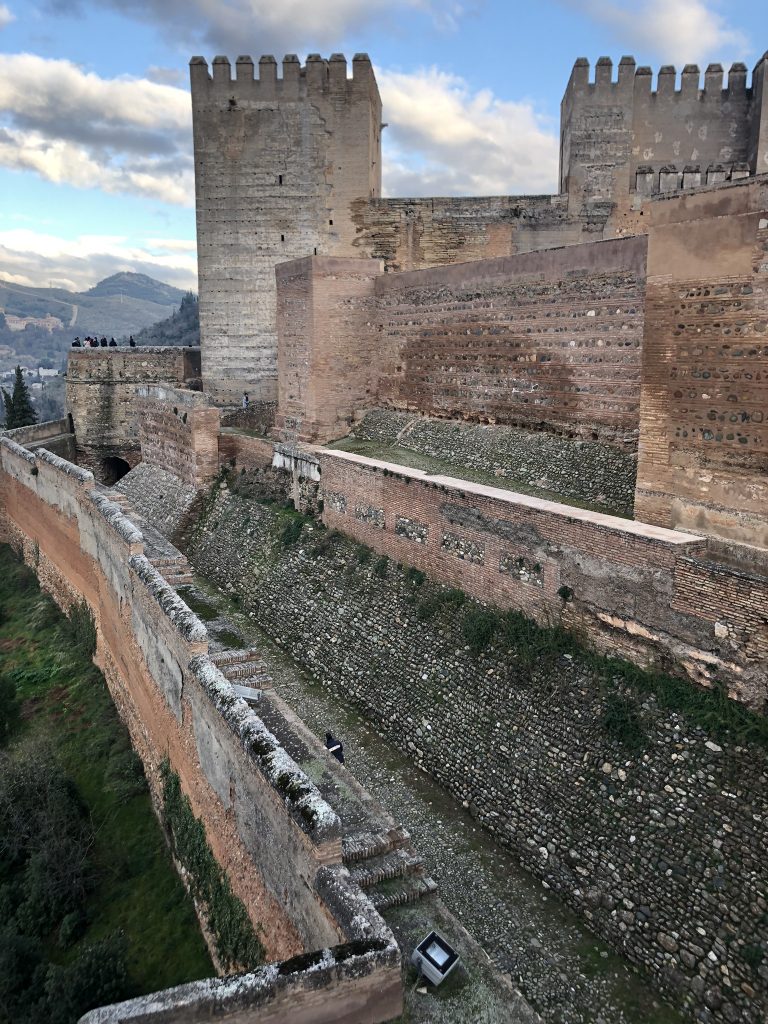

And you need tickets to tour the General life area, where you get to see…you know…general life. We actually missed seeing general life choosing instead to get a general round of drinks at the cafe. We ended the day with a hike down the backside of Alhambra as dark set in, which was actually one of the best parts as you can see the ramparts and the aqueduct all lit up and glorious.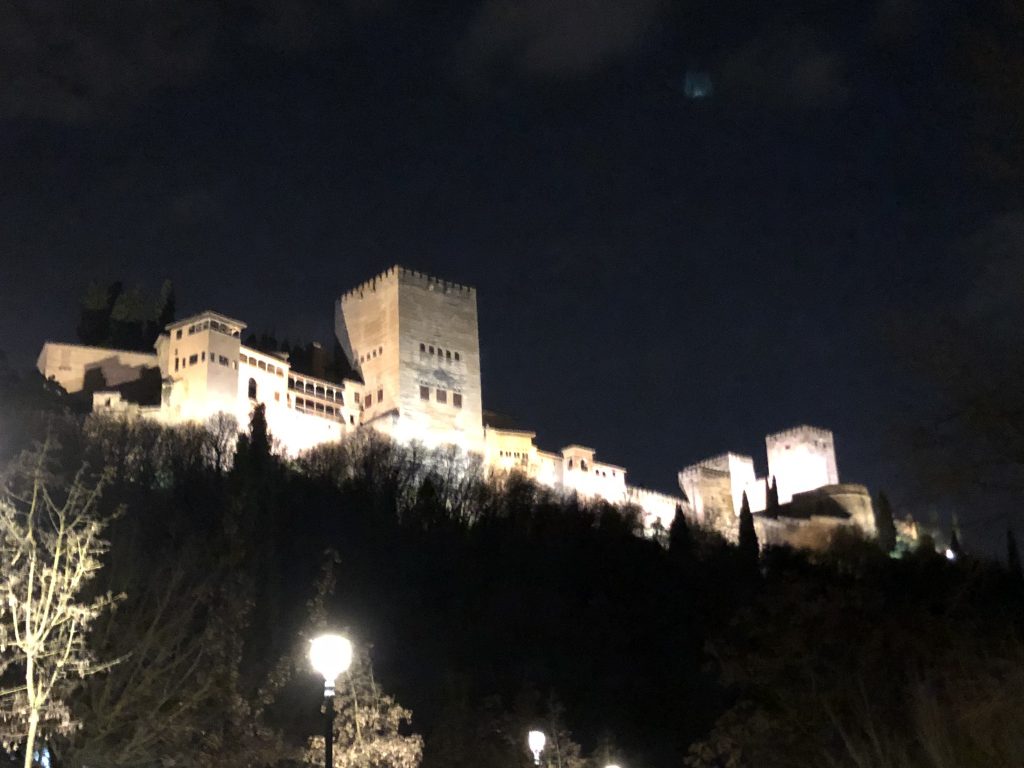
Aside from Alhambra, Granada has a monstrous Cathedral and a lot of winding streets that lead to lookout points where you can gaze at…you guessed it… Alhambra. We spent an entire day getting lost on narrow cobbled alleys, eating pastries and drinking beer. 

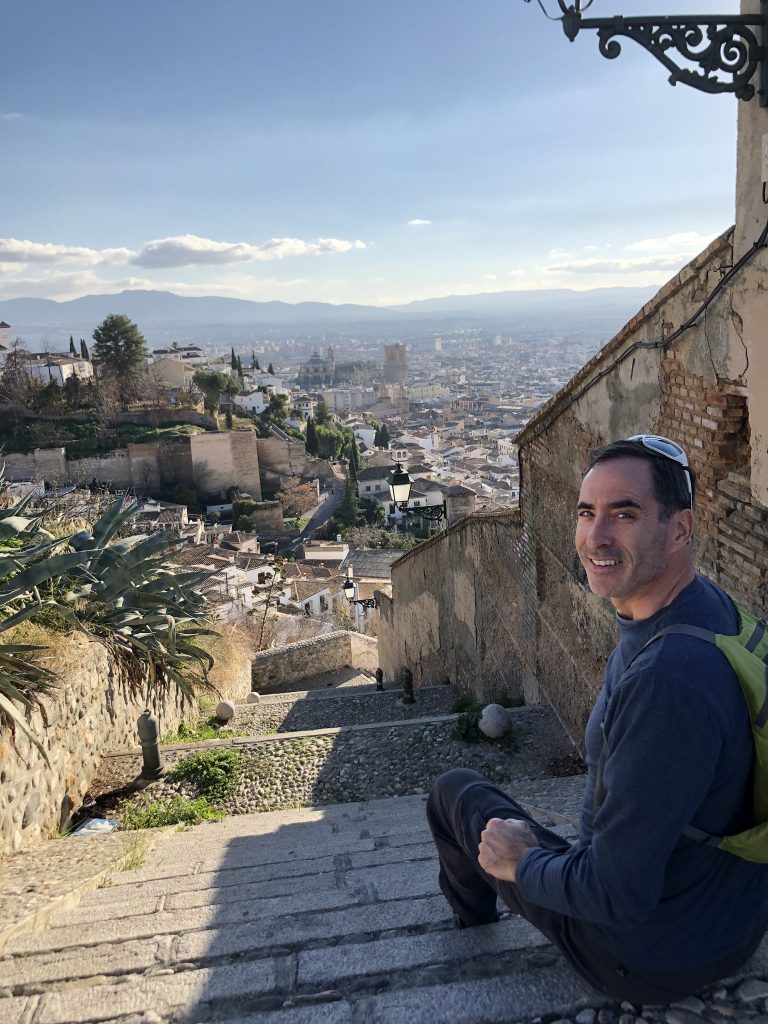
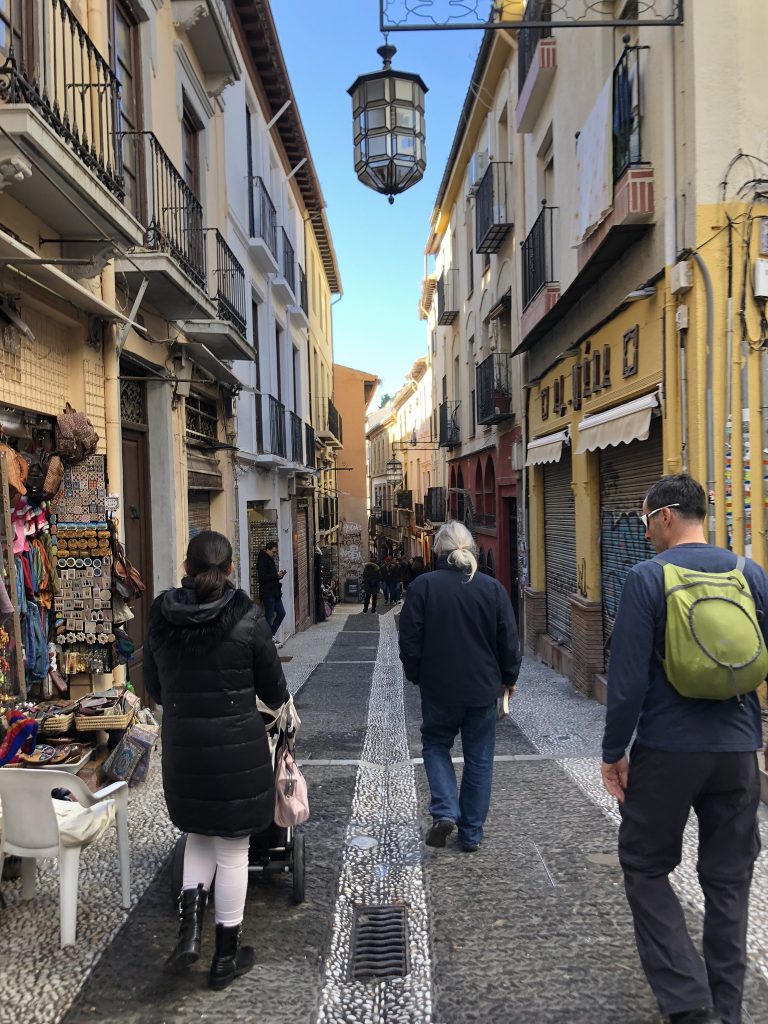
That was pretty much our whole stay in Granada. Maya had completely abandoned us after Alhambra, having developed a head cold that gave her the excuse she needed to stay in the AirBnB all day after a single morning outing to eat churros y chocolate at a hillside Pasteleria.
Having had our fill of touristy Granada and Alhambra, we hopped another bus at 8:00 am on the 31st to head to Seville, the last of the Andalusian city trifecta.
 So arriving in Seville on the 31st of December has its advantages: you can join the locals in the Plaza Nueva eating ice cream to celebrate the new year. Of course if you are eating ice cream, you will stick out like a sore thumb. The locals eat grapes. 12 of them to be precise: 1 for every second prior to the new year. In fact they even sell pre-seeded and pre-peeled grapes so you will be more likely to succeed at this task. We only found out the timing challenge of the grape eating after the fact and instead ate our grapes at a more leisurely pace at about 11 pm after eating ice cream.
So arriving in Seville on the 31st of December has its advantages: you can join the locals in the Plaza Nueva eating ice cream to celebrate the new year. Of course if you are eating ice cream, you will stick out like a sore thumb. The locals eat grapes. 12 of them to be precise: 1 for every second prior to the new year. In fact they even sell pre-seeded and pre-peeled grapes so you will be more likely to succeed at this task. We only found out the timing challenge of the grape eating after the fact and instead ate our grapes at a more leisurely pace at about 11 pm after eating ice cream.


 A New Year’s Eve arrival also has its disadvantages: nothing is open after 5pm and all the local historical treasures are closed on the 1st. The two big things to see are the Alcázar and the Cathedral – both closed. But there is also a Plaza de Toros (bull fighting), a Torre de Oro and various other completely closed or fully booked sites of interest. We saw all of them only from the outside and were forced to make our own interpretation of the wonders within (see below for Maya and Joe bull fighting outside the Plaza de Toros and trying to figure out what’s in those darn cannons at the Torre del Oro).
A New Year’s Eve arrival also has its disadvantages: nothing is open after 5pm and all the local historical treasures are closed on the 1st. The two big things to see are the Alcázar and the Cathedral – both closed. But there is also a Plaza de Toros (bull fighting), a Torre de Oro and various other completely closed or fully booked sites of interest. We saw all of them only from the outside and were forced to make our own interpretation of the wonders within (see below for Maya and Joe bull fighting outside the Plaza de Toros and trying to figure out what’s in those darn cannons at the Torre del Oro).
Lucky for us the local Segway tour guides were still on duty. So we headed for our Segway tour with Angela at 11 am on the 1st. It was our first ever Segway experience and I have to say it was more fun than I expected. I thought we would just look like lame tourists in goofy helmets lazily zooming around Seville. It turns out we were lame tourists in goofy helmets lazily zooming around Seville!!! 


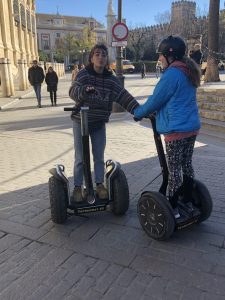
We hit the old Tobacco factory, the Plaza de España, the Cathedral, etc and learned a lot of cool things. For example did you know that the Cathedral of Seville is the biggest gothic cathedral of Europe and the third largest, period!? Did you know that at one time 80% of all the world’s cigarettes came out of Seville and they were only rolled by women and all the tobacco came from America!?! Did you know that Magellan left from Seville in 1519 with 5 ships and 270 men to circumnavigate the earth and they returned 3 years later with 1 ship and 18 men?!? Finally did you know that both Maya and our tour guide Angela are vehemently opposed to bull fighting?!? The things one learns on a Segway tour!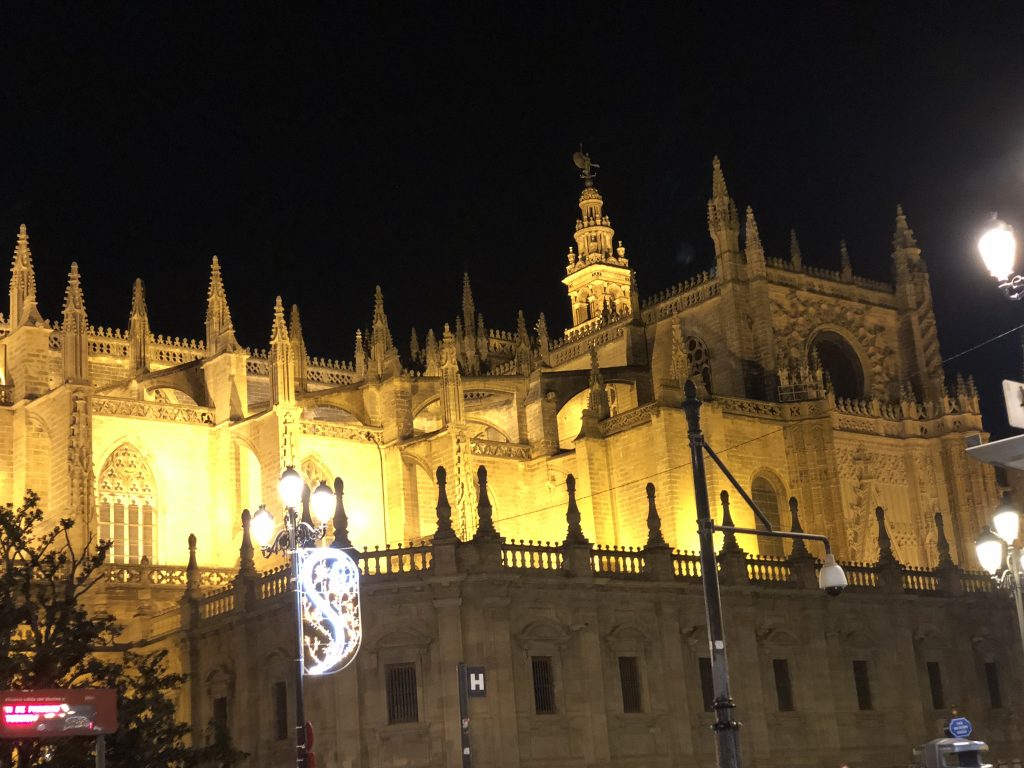
Aside from the Segway tour we got to do exactly nothing because of the holiday. But here are some cool pics of the cathedral at night, the three kings crowns  (Spain celebrates Dia de los Reyes on January 6), the Plaza de España that was designed for the 1929 World’s fair, the Plaza del Salvador, and Las Setas de Seville which is called ‘the Mushroom’ by the locals (there are actually Roman ruins underneath it that you can view, which were discovered during the construction).
(Spain celebrates Dia de los Reyes on January 6), the Plaza de España that was designed for the 1929 World’s fair, the Plaza del Salvador, and Las Setas de Seville which is called ‘the Mushroom’ by the locals (there are actually Roman ruins underneath it that you can view, which were discovered during the construction). 

 It wasn’t all a loss as
It wasn’t all a loss as
Seville is also the home of really good tapas and there were a few tapas bars open for business.
We left on January 2nd on a high speed train to Malaga for our last day in Spain, having eaten way too much tapas and churros. Someday perhaps we’ll come back for the cathedral and the Alcazar. I feel confident they will both survive a few more years until I get to see them. In Malaga there wasn’t much time to do any touring. I had been to Malaga back in March, 2018 so I was able to run us by the main attractions, which included…you guessed it, a cathedral and a fort.
Malaga also has a lot of modern art museums including a big Picasso exhibit. I’m usually quite a Philistine, not really getting modern art but I have to admit I really enjoyed the brand of art at the Malaga museums. Even I can appreciate a big room of fake sheep, an allegory for either politics or religion. Take your pick.
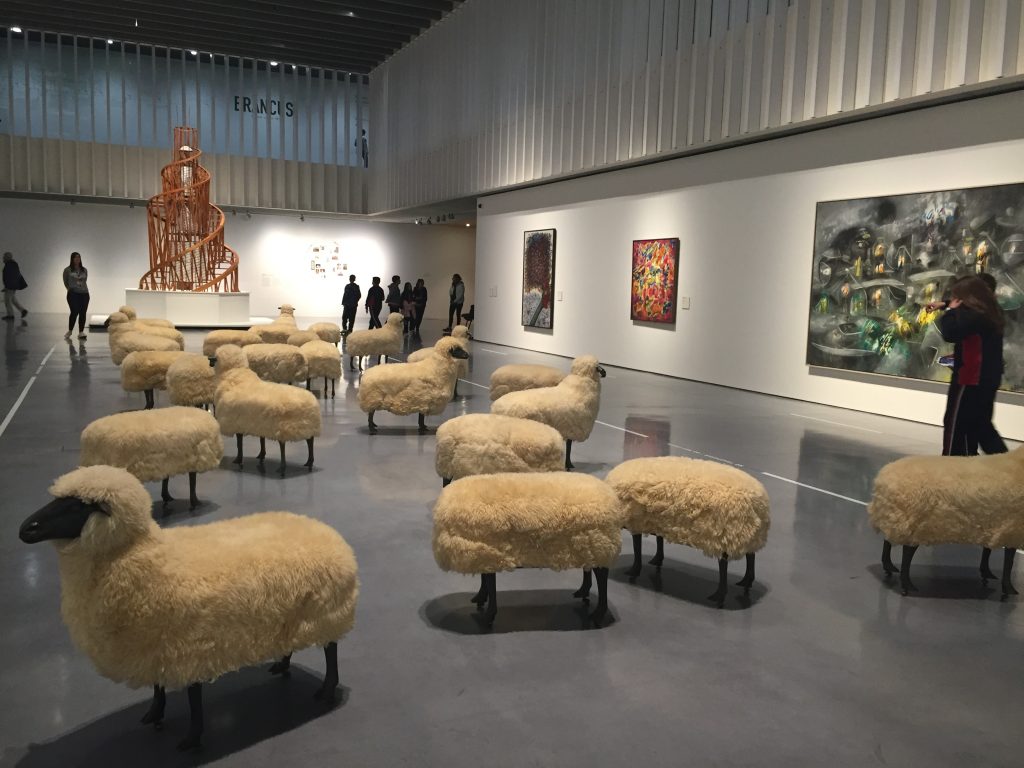
Maya was partial to the beautiful beach and took several selfies there to send to friends. I got Joe to pose on the beach. I’m pretty sure he is GQ magazine worthy in these shots and I deserve credit for capturing his daring beauty.



After the beach we hiked up the hill to the Gilbralfaro Castle, which was closed but gave some beautiful views of the city from the Mirador (Spanish for ‘lookout point’ and probably one of the most common words seen on our trip aside from tapas and cerveza).


After working up an appetite, two of us headed for…wait for it… tapas y cervezas.  One of us headed for helado (ice cream), and then we all headed for churros y chocolate. Joe was ill prepared for the cloyingly sweet chocolate pudding like substance in which one dips the sticks of fried bread.
One of us headed for helado (ice cream), and then we all headed for churros y chocolate. Joe was ill prepared for the cloyingly sweet chocolate pudding like substance in which one dips the sticks of fried bread.
Well our tour following the Berbers from North Africa into Andalusia was at an end. We decided to skip the part where the Moors are chased out of Castilian Spain and flee for their lives back to Africa in the dead of night, instead choosing a morning flight out of Malaga to return to the US. My Spanish had vastly improved by the end (by which I mean I could consistently order tapas and beer and ask for directions), and I found the Spanish the most tolerant so far in our travels of lousy language speakers. They let me struggle in Spanish, answering back in Spanish and augmenting with near perfect English only when necessary. Could be the long history of cultural mixing that ingrains a certain tolerance in them or an enduring embarrassment over the Inquisition. Hard to say. But I sure wish Americans could be a bit more like the Andalusians. When we get home, we are going to emulate them in at least one respect: Joe has been watching Spanish cooking videos and has grand plans to introduce a Spanish tortilla into the Abraham household meal rotation. Muy delicioso!